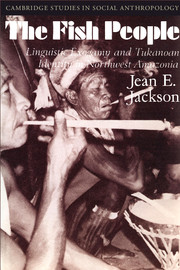Book contents
- Frontmatter
- Contents
- List of figures, maps, and tables
- Preface
- Acknowledgments
- Note on orthography
- 1 Purpose and organization of the book
- 2 Introduction to the Central Northwest Amazon
- 3 The longhouse
- 4 Economic and political life
- 5 Vaupés social structure
- 6 Kinship
- 7 Marriage
- 8 Tukanoans and Makú
- 9 The role of language and speech in Tukanoan identity
- 10 Male and female identity
- 11 Tukanoans' place in the cosmos
- 12 Tukanoans and the outside world
- 13 Conclusions: themes in Tukanoan social identity
- Notes
- Glossary
- References
- Index
- CAMBRIDGE STUDIES IN SOCIAL ANTHROPOLOGY
13 - Conclusions: themes in Tukanoan social identity
Published online by Cambridge University Press: 05 June 2012
- Frontmatter
- Contents
- List of figures, maps, and tables
- Preface
- Acknowledgments
- Note on orthography
- 1 Purpose and organization of the book
- 2 Introduction to the Central Northwest Amazon
- 3 The longhouse
- 4 Economic and political life
- 5 Vaupés social structure
- 6 Kinship
- 7 Marriage
- 8 Tukanoans and Makú
- 9 The role of language and speech in Tukanoan identity
- 10 Male and female identity
- 11 Tukanoans' place in the cosmos
- 12 Tukanoans and the outside world
- 13 Conclusions: themes in Tukanoan social identity
- Notes
- Glossary
- References
- Index
- CAMBRIDGE STUDIES IN SOCIAL ANTHROPOLOGY
Summary
Types of comparisons
Much of the discussion in this book has followed out of postulating a series of polarized contrasts in Tukanoan classifications of people. Some of these contrasts constitute entire chapters (e.g., Tukanoan–Makú, male–female, Tukanoan–white), whereas others (e.g., coresident–other, own-language group–other) are described in several chapters. Although most contrasts are dichotomies, some are trichotomies, most notably the agnate–affine–mother's child contrast. Accentuating such polarities is a useful tactic for explicating the major differences between various classes of people and nonpeople important in Tukanoan social structure.
Another type of comparison consists of a class of elements ordered along a continuum according to their possession of varying amounts of a particular property. Examples of this are the birth order of siblings and the system of ranked sibs within a language group.
A third type of comparison also involves the notion of continuum, but in this case one end of the continuum is the core or nucleus and the other end is peripheral, whose significance mainly derives from being the opposite of the core. An example of this is the longhouse, the symbol of all that is human, social, and spiritual. Next in order on the scale are the river, the forest, and finally the wild and anomalous features of the landscape, such as tatá boa (naturally occurring forest clearings) and the rocky outcrops and caves sporadically looming high above the forest floor.
- Type
- Chapter
- Information
- The Fish PeopleLinguistic Exogamy and Tukanoan Identity in Northwest Amazonia, pp. 227 - 242Publisher: Cambridge University PressPrint publication year: 1983



